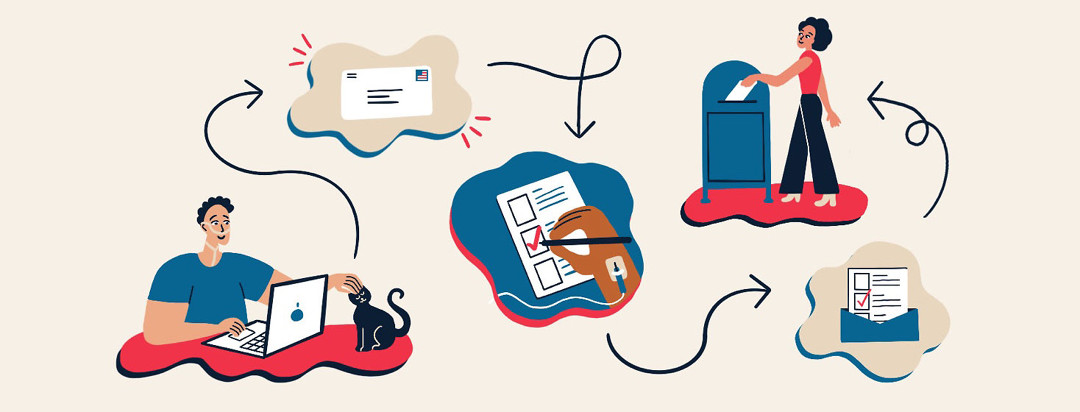Voting With A Health Condition: What To Know
Voting is a fundamental American right, but it has special meaning for people with disabilities or health conditions. Until federal laws like the Americans with Disabilities Act (ADA) were enacted, Americans who had physical limitations often did not vote at all. It took years of hard work and advocacy for these rights to be granted – and voting for candidates whose records on healthcare and disability rights match your values helps to keep these rights safe.1
This year, the coronavirus pandemic has many of us talking about the safest ways to vote. In this article, we take you through the steps of registering to vote, planning which voting method is best for you, and finally casting your vote – all with important tips and advice for people with disabilities or certain health conditions. If you are not sure which voting method will work best for you, talk to your doctor.
First, register to vote
This is the first step in ensuring that you can vote, and it should be done as soon as possible. Visit vote.org to register to vote in your state or to check that your registration is active and correct. If you are not yet registered, you can register to vote online.
If you need additional help registering to vote, 2 federal laws are on your side: The National Voter Registration Act of 1993 (NVRA) and the ADA require that your state make voter registration accessible to all eligible voters. According to the NRVA, any office in your area that provides public assistance to people with disabilities must help you fill out your voter registration forms and then deliver those forms to election officials. If this office provides services at home, then voter registration help must be performed at home, too.1
Next, find your state’s voting options
Each state will provide specific information on how people with disabilities can vote. You can look up your state’s voting accessibility guide here. Once you know your options, you can decide which one best fits your needs, concerns, and abilities.
Finally, choose a way to vote
Most of us will have 2 basic options: Voting by mail, or voting in person. We explain each option below, with a special focus on what people with disabilities or health conditions should look out for.
How to vote by mail with a disability
Voting by mail, also known as using an absentee ballot, may be the safest way to vote this year if you are at high risk for COVID-19. With large turnouts expected, voting by mail can also help you avoid waiting in line for long periods of time, which can be uncomfortable for people with physical disabilities or other conditions such as incontinence or fatigue.
Every state gives people the option to vote by mail, but you will need to learn your state’s exact rules in order to participate. Visit your state’s local election office website to learn your state’s vote by mail rules.2
Here are a few things to consider when voting by mail:
- Request and mail in your ballot as soon as possible to avoid mail delays.
- Read all directions carefully. It is important to read all of the directions included with your ballot, from how to fill it out to how to send back your completed ballot. Not doing this properly could mean that your ballot will not be counted.
- Sign your ballot. People with Parkinson’s Disease, tremor, or difficulty writing should consider their state’s requirements for signatures that do not match. It is unfortunate, but a difference in signatures can invalidate your ballot.
- Get help filling out your ballot, if you need it. This can be a challenge to people with visual impairment or difficulty writing. Visually impaired people may have their ballots marked by a sighted assistant. If this makes you uncomfortable, consider voting in person.3
- Track your ballot. Some states offer online tracking to see if your ballot has been received and counted.
How to vote in person with a disability
Voting in person can be challenging in itself to people with disabilities, but the coronavirus pandemic has added a new layer of things to consider.
First of all, general pandemic rules apply: Mask up and maintain 6 feet of distance between yourself and other people, both when you are waiting on line inside and outside. Also, carry your own pen or a bottle of hand sanitizer, in case you are asked to sign anything or touch anything that is given to you, such as paperwork.
Here are a few other things to consider when voting in person:
- An accessible polling place is your right. No matter which state you vote in, accessible voting is the law. The ADA requires that your polling place be accessible to people with disabilities. If the building cannot be made accessible, curbside voting must be offered.1
- You also have the right to an accessible voting machine. The Help America Vote Act of 2002 (HAVA) requires your polling place to have at least 1 accessible voting system. Not only should this system be accessible, it should let you vote privately and independently.1,4
- See if you can vote early.Your state may offer early in-person voting. This option may help you avoid crowds.
- Prepare for a wait. Do not be caught unprepared if your polling place has a long line. Wear comfortable clothes and shoes, pack food and water, and bring any medications that you may need to take while you wait.
Reporting a voting rights problem
If you have a problem at any step of the way, from registering to vote to independently casting your ballot, the National Disability Rights Network can connect you with advocacy services in your state.
Voting is a process, but it is well worth it. Plus, it is your right as an American. Thank you for using your power and making your voice heard.

Join the conversation